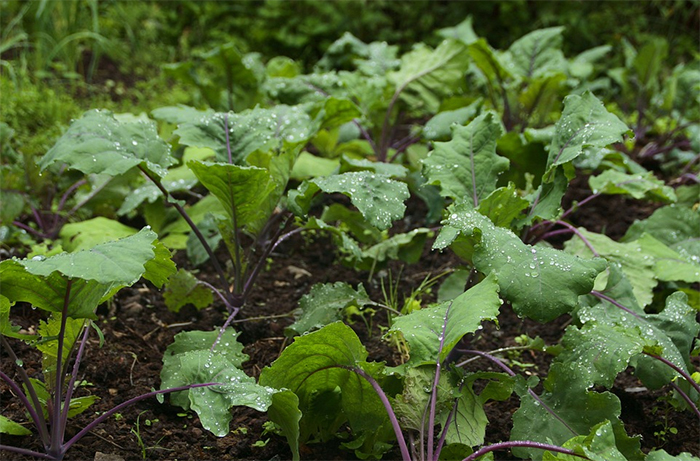

In the last 30 years I’ve been in and out of the Dominican Republic more times than I can count. But it wasn’t until recently—when I built the SOMOS Center and moved here—that I started getting the most out of this beautiful land. And I mean that very literally.
Before last year, I used to return to the United States craving fresh greens. Often, I’d make a beeline straight from the airport to my favorite salad bar. But now that I have my own space, and the Global Roots gardens, I can plant as many organic greens as I want. And trust me, I have. At the moment I have a lot of swiss chard and kale (about 80 plants in total).
Kale is one of the most nutrient dense foods on the planet, jam packed with vitamins A, B6, K, and C.
I’d like to focus today on that kale. Not only because it’s become an important part of my diet, but also because of its increasing popularity among consumers. Business Insider published an article a couple years ago about the explosion in kale consumption and production around the United States, starting around 2012. As for Global Roots, our own boom in production is a more recent phenomenon. I’m currently growing three types of kale in my garden: curly kale, lacinato kale (also known as Tuscan kale), and red kale.
I’m not really fond of the word “superfood.” It seems to me the label has been so overused that it’s lost all meaning. Let’s stick to specifics:
Now—would I call kale a superfood? No, I don’t think I would. If anything, the term doesn’t do justice to my leafy friend.

One of the great things about kale is that it can be grown in most climates, though it does thrive especially well in cooler temperatures. For those who want to plant kale in pots, it’s recommended that your plants receive at least six hours of direct sunlight. However, I think it’s okay if it receives more sunlight. As you know, I’m here in the tropics, and my kale is in the direct sunlight all day and growing like gangbusters.
But let’s back up a bit. First, if you’re starting from scratch, you’ll have to germinate the seeds. The easiest way is to tuck your seeds into a moist paper towel, put it in a sandwich bag, and keep it somewhere warm and away from too much direct sunlight. Or you can germinate it like we do here at Global Roots—in seed trays. In the States, I like using biodegradeable and organic seed trays. And remember, it’s important to use rich soil in your trays. In terms of watering, make sure not to overwater. A light sprinkle will do. In short, these seeds need bright light and a steady, moderate supply of water.

While the seeds are germinating, you’ll want to make sure you have a good soil ready to go. It’s important that you use high quality organic fertilizer, even if you have to improvise a bit. Here at the Global Roots gardens, we added soils from an old pig pen and from the cacao forest to our garden beds. Soil from the forest is particularly fertile, as the decomposed cacao pods are really rich. For those who want more info on preparing your soil, please visit The Spruce. They have many great articles on how to prepare rich and healthy soil.
Kale plants, when properly cared for—pruned when necessary, watered carefully, harvested intelligently—can last for months, even years.
Once your seeds have germinated and have reached 2-3 inches, you’ll be ready to plant your kale. After planting, you need to water daily. The best times of day to water are early in the morning or late in the afternoon. Watering in the middle of the day, when the sun is at its most intense, is both wasteful (much of the water will evaporate) and potentially harmful to your plants.
When harvesting, always start with the large leaves on the bottom. Make sure to remove the entire leaf, from all the way at the base of the stem. The reason you should pick leaves from the bottom is that new kale leaves grow from the top of the plant. Picking from the top is a lot like jumping the proverbial gun, and not at all good for the long-term health of the plant.
It’s also important that you keep a watchful eye on the bottom leaves, between harvests. If, for example, you notice that the bottom leaves have dried out, make sure to remove them. Taking care of your kale will ensure good harvests, not just once or twice, but throughout the lifecycle of the plant.
I planted my kale 14 months ago and it’s still going strong. And that’s the wonderful thing about having a garden: life is the default setting. You don’t have to prod the earth forcefully to enjoy its rewards; you just have to take care. Kale plants, when properly cared for—pruned when necessary, watered carefully, harvested intelligently—can last for months, even years.
I often eat kale several days in a row. There are so many wonderful ways to prepare kale, but here I’m going to share two of my favorite cooked ways to eat kale: Peanutty Greens With Maduras and Sweet Potatoes and Kale and two of my favorite kale salads are the Hearty and Filling Kale Salad and the Simple Kale Salad.
Copyright 2024 Center for Nutrition Studies. All rights reserved.